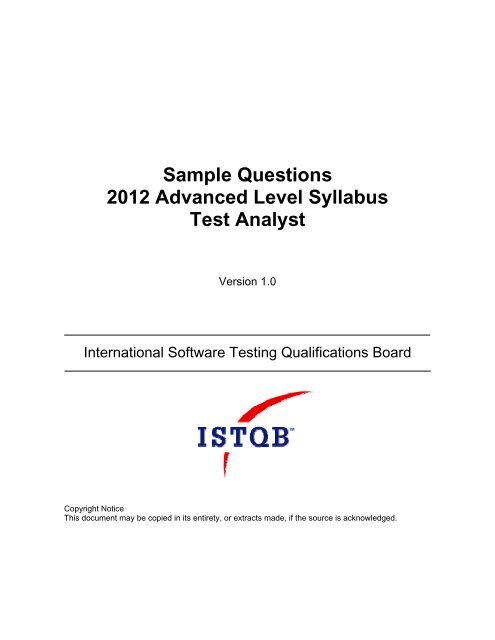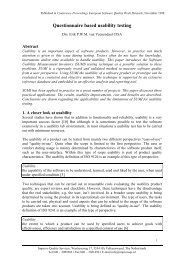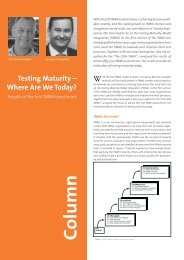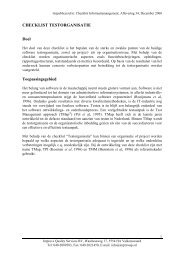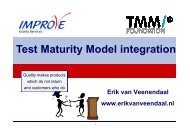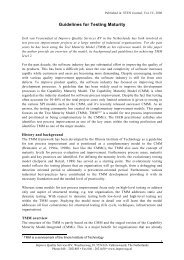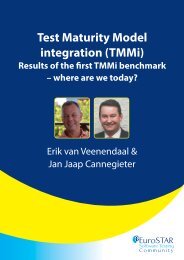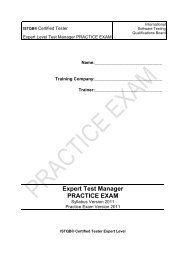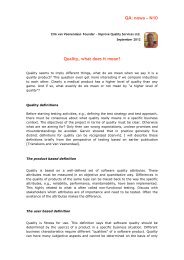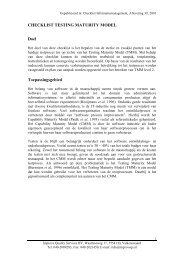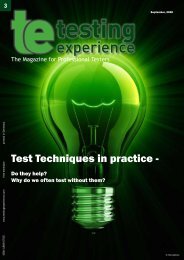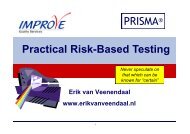Sample Questions 2012 Advanced Level Syllabus Test Analyst
Sample Questions 2012 Advanced Level Syllabus Test Analyst
Sample Questions 2012 Advanced Level Syllabus Test Analyst
You also want an ePaper? Increase the reach of your titles
YUMPU automatically turns print PDFs into web optimized ePapers that Google loves.
<strong>Sample</strong> <strong>Questions</strong><strong>2012</strong> <strong>Advanced</strong> <strong>Level</strong> <strong>Syllabus</strong><strong>Test</strong> <strong>Analyst</strong>Version 1.0International Software <strong>Test</strong>ing Qualifications BoardCopyright NoticeThis document may be copied in its entirety, or extracts made, if the source is acknowledged.
Certified <strong>Test</strong>er<strong>Advanced</strong> <strong>Level</strong> <strong>Syllabus</strong> – <strong>Test</strong> <strong>Analyst</strong>InternationalSoftware <strong>Test</strong>ingQualifications BoardTable of ContentsAcknowledgements ................................................................................................................................. 30. Introduction ..................................................................................................................................... 40.1 Purpose of this document ...................................................................................................... 40.2 Instructions ............................................................................................................................. 41. ATA <strong>Sample</strong> <strong>Questions</strong> .................................................................................................................. 5CTAL-ATA _LO-1.2.1 .......................................................................................................................... 5CTAL-ATA _LO-1.3.1 .......................................................................................................................... 5CTAL-ATA _LO-1.4.1 .......................................................................................................................... 6CTAL-ATA _LO-1.5.1 .......................................................................................................................... 7CTAL-ATA _LO-1.5.2 .......................................................................................................................... 7CTAL-ATA _LO-1.5.3 .......................................................................................................................... 9CTAL-ATA _LO-1.6.1 .......................................................................................................................... 9CTAL-ATA _LO-1.7.1 ........................................................................................................................ 10CTAL-ATA _LO-1.8.1 ........................................................................................................................ 11CTAL-ATA _LO-1.9.1 ........................................................................................................................ 11CTAL-ATA _LO-2.2.1 ........................................................................................................................ 12CTAL-ATA _LO-2.3.1 ........................................................................................................................ 13CTAL-ATA _LO-2.4.1 ........................................................................................................................ 13CTAL-ATA _LO-2.4.2 ........................................................................................................................ 14CTAL-ATA _LO-3.2.1 ........................................................................................................................ 15CTAL-ATA _LO-3.2.2 ........................................................................................................................ 15CTAL-ATA _LO-3.2.3 ........................................................................................................................ 16CTAL-ATA _LO-3.2.4 ........................................................................................................................ 17CTAL-ATA _LO-3.2.5 ........................................................................................................................ 18CTAL-ATA _LO-3.2.6 ........................................................................................................................ 20CTAL-ATA _LO-3.2.7 ........................................................................................................................ 21CTAL-ATA _LO-3.2.8 ........................................................................................................................ 22CTAL-ATA _LO-3.2.9 ........................................................................................................................ 24CTAL-ATA _LO-3.2.10 ...................................................................................................................... 24CTAL-ATA _LO-3.2.11 ...................................................................................................................... 25CTAL-ATA _LO-3.3.1 ........................................................................................................................ 26CTAL-ATA _LO-3.3.2 ........................................................................................................................ 26CTAL-ATA _LO-3.4.1 ........................................................................................................................ 27CTAL-ATA _LO-3.4.2 ........................................................................................................................ 28CTAL-ATA _LO-4.2.1 ........................................................................................................................ 29CTAL-ATA _LO-4.2.2 ........................................................................................................................ 29CTAL-ATA _LO-4.2.3 ........................................................................................................................ 30CTAL-ATA _LO-4.2.4 ........................................................................................................................ 31CTAL-ATA _LO-5.1.1 ........................................................................................................................ 32CTAL-ATA _LO-5.2.1 ........................................................................................................................ 32CTAL-ATA _LO-5.2.2 ........................................................................................................................ 34CTAL-ATA _LO-6.2.1 ........................................................................................................................ 36CTAL-ATA _LO-6.3.1 ........................................................................................................................ 36CTAL-ATA _LO-6.4.1 ........................................................................................................................ 37CTAL-ATA _LO-6.5.1 ........................................................................................................................ 38CTAL-ATA _LO-7.2.1 ........................................................................................................................ 38CTAL-ATA _LO-7.2.2 ........................................................................................................................ 39CTAL-ATA _LO-7.2.3 ........................................................................................................................ 39<strong>Sample</strong> <strong>Questions</strong> – ATA Page 2 of 40 19 October, <strong>2012</strong>© International Software <strong>Test</strong>ing Qualifications Board
Certified <strong>Test</strong>er<strong>Advanced</strong> <strong>Level</strong> <strong>Syllabus</strong> – <strong>Test</strong> <strong>Analyst</strong>InternationalSoftware <strong>Test</strong>ingQualifications Board0. Introduction0.1 Purpose of this documentThe sample questions, answer sets and associated justifications in this document have been createdby a team of Subject Matter Experts and experienced question writers with the aim of assistingISTQB® Member Boards and Exam Boards in their question writing activities.These questions cannot be used as-is in any official examination, but they should serve as guidancefor question writers. Given the wide variety of formats and subjects, these sample questions shouldoffer many ideas for the individual Member Boards on how to create good questions and appropriateanswer sets for their examinations.0.2 InstructionsThe question and answer sets are organized in the following way:• Learning Objective and K-level• Question - including any scenario followed by the question stem.• Answer Set - correct answer(s) are indicated in bold face.• Justification of the answers.• Suggested point value for the question.<strong>Sample</strong> <strong>Questions</strong> – ATA Page 4 of 40 19 October, <strong>2012</strong>© International Software <strong>Test</strong>ing Qualifications Board
Certified <strong>Test</strong>er<strong>Advanced</strong> <strong>Level</strong> <strong>Syllabus</strong> – <strong>Test</strong> <strong>Analyst</strong>InternationalSoftware <strong>Test</strong>ingQualifications Board1. ATA <strong>Sample</strong> <strong>Questions</strong>CTAL-ATA _LO-1.2.1TA-1.2.1 (K2) Understand how the timing and level of involvement for the test analyst varies whenworking with different lifecycle models (e.g., V-model, iterative including agile)Question:Which of the following statements is TRUE with respect to when the test analyst should becomeinvolved during different lifecycle models?Answer Set:A. In sequential V-model projects the test analyst should start test analysis concurrentlywith requirement specificationB. In Agile projects the test analyst should start test analysis and design concurrently with codingC. In sequential V-model projects the test analyst should start test analysis concurrently withcodingD. There are no differences in the moment of involvement for test analysts for the varioussoftware lifecyclesJustification:A. Correct: This is the correct option of how testing activities should be aligned to the sequentiallifecycle model phasesB. Incorrect: As stated in the syllabus the analyst should be involved from the beginning of anagile project.C. Incorrect: test analysis must start earlier, already during requirement specification insequential lifecycle models.D. Incorrect: as stated in the syllabus, there may be many differences in how the testing activitiesare alignedPoint Value: 1CTAL-ATA _LO-1.3.1TA-1.3.1 (K2) Summarize the activities performed by the <strong>Test</strong> <strong>Analyst</strong> in support of planning andcontrolling the testingQuestion:Which of the following is a type of testing that someone in the role of a <strong>Test</strong> <strong>Analyst</strong>, working with the<strong>Test</strong> Manager, should typically consider and plan for?Answer Set:A. UsabilityB. SecurityC. Performance<strong>Sample</strong> <strong>Questions</strong> – ATA Page 5 of 40 19 October, <strong>2012</strong>© International Software <strong>Test</strong>ing Qualifications Board
Certified <strong>Test</strong>er<strong>Advanced</strong> <strong>Level</strong> <strong>Syllabus</strong> – <strong>Test</strong> <strong>Analyst</strong>InternationalSoftware <strong>Test</strong>ingQualifications BoardD. MaintainabilityJustification:A. Correct per the syllabus.B. Incorrect: This is the responsibility of the TTA.C. Incorrect: This is the responsibility of the TTA.D. Incorrect: This is the responsibility of the TTA.Point Value: 1CTAL-ATA _LO-1.4.1TA-1.4.1 (K4) Analyze a given scenario, including a project description and lifecycle model, todetermine the appropriate tasks for the <strong>Test</strong> <strong>Analyst</strong> during the analysis and design phases.Question:A project has been initiated to collect and analyze usage of a web-based search tool in order tooptimize search results for particular groups of users. The project will build on initial analysis of userdata collected over a period of time and will aim to refine the collection and analysis ‘engines’ so thatrelevant data can be collected and analyzed in real time, enabling users to focus their search moreeffectively.The project will use agile techniques in an iterative/incremental life cycle. Requirements are based onuser stories and these will be explored during short ‘sprints’. The sprints will be grouped to focus ondata collection for the first part of the project and analysis for the second part.Risks include the inability to analyze the volume of data collected, inability to collect data for thedesired analysis, inadequate speed and response times, and poor user interface.The testing for the first part has been scoped and requirements have been documented and reviewedwith no major concerns arising.Which one of the following answers describes the most appropriate and complete sequence ofactivities for the TA to focus on during test analysis and design?Answer Set:A. Analyze user stories, identify test conditions at appropriate levels to address userstories, add test conditions for risk mitigation, select test case design techniques toachieve desired coverage, create test casesB. Analyze user stories, select test case design techniques, create high level test conditions forrisk mitigation, create test cases to achieve desired coverage for user stories, create riskmitigation test casesC. Select test case design techniques, create high level test cases to meet test conditions,create high level test cases to mitigate risks, create low level tests cases to achieve desiredcoverage.D. Analyze risks, create test conditions to address risks, create high level test cases to meet testconditions for risk mitigation and user stories, create all low level test cases.Justification:A. Correct: with risk mitigation added on to user story test conditions.B. Incorrect: This option ignores test conditions for risk mitigation and goes straight to test cases,and it is not specific about the objectives of test conditions.C. Incorrect: This option ignores test conditions altogether and goes straight to test cases.<strong>Sample</strong> <strong>Questions</strong> – ATA Page 6 of 40 19 October, <strong>2012</strong>© International Software <strong>Test</strong>ing Qualifications Board
Certified <strong>Test</strong>er<strong>Advanced</strong> <strong>Level</strong> <strong>Syllabus</strong> – <strong>Test</strong> <strong>Analyst</strong>InternationalSoftware <strong>Test</strong>ingQualifications BoardD. Incorrect: This option ignores analysis of user stories and omits mention of desired coverage.Point Value: 2CTAL-ATA _LO-1.5.1TA-1.5.1 (K2) Explain why test cases should be understood by the stakeholdersQuestion:Which one of the following statements does NOT give a good reason why test cases should bereviewed and understood by stakeholders?Answer Set:A. The test manager reviews the test cases in order to control the work of the test analystand to create the organization’s test strategyB. Customer and users review the test cases in order to verify them against requirements,business processes and business rulesC. <strong>Test</strong>ers review test cases written by other testers in order to ensure that the test cases areconsistent, understandable and executable by testers other than the authorD. Developers review test cases written by testers in order to align their understanding ofrequirements with the testers’ and to align component testing with system testingJustification:A. Correct: test cases should be created to comply with the test policy, not the other way around.B. Incorrect: Yes this is one of the good reasons, that is to verify that the test cases match thebusiness processes and rules.C. Incorrect: Yes this is another good reason, namely that other testers should be able tounderstand and execute test cases.D. Incorrect: Yes, developers need to be sure that they have the same understanding of therequirements as the testers in order to catch misunderstandings and also to participate in theoptimization of tests.Point Value: 1CTAL-ATA _LO-1.5.2TA-1.5.2 (K4) Analyze a project scenario to determine the most appropriate use for low level(concrete) and high level (logical) test casesQuestion:Scenario: Health InsuranceThe IT department of insurance company SecureLife has started a project IQ (Improved Quality) toimplement a new health insurance application to make it possible to create online transactions forhealth insurance claims raised by employees and members of companies or associations havinghealth insurance agreements. In the new application it will be possible to make registration of all theinformation about the employees, their age, health conditions, etc. The project also has to fulfill thedemands of the people doing insurance calculation, actuaries and the demands from public legislation.<strong>Sample</strong> <strong>Questions</strong> – ATA Page 7 of 40 19 October, <strong>2012</strong>© International Software <strong>Test</strong>ing Qualifications Board
Certified <strong>Test</strong>er<strong>Advanced</strong> <strong>Level</strong> <strong>Syllabus</strong> – <strong>Test</strong> <strong>Analyst</strong>InternationalSoftware <strong>Test</strong>ingQualifications BoardThe project team for IQ have testers who are business users with lots of domain knowledge butwithout much formal test training.At the same time another project, HIPPOS (Health Insurance Product Public Order Sales), has beenstarted by the marketing department of SecureLife with the purpose of launching a new Internetapplication that will allow potential buyers of health insurance to use a small calculator to calculateinsurance premiums and possible bonus deductions based on age and different health parameters.This application will also allow individual customers to order Health Insurance Products online.The marketing tool and web page of project HIPPO will be developed and tested by SecureLife’s Agiledevelopment team, which has worked together for the last three years with the marketing department,developing marketing web applications. The Agile team consists of well trained testers anddevelopers. They have implemented test automation for configuration and regression testing and theyhave as part of their retrospectives built check lists of common defects and common securityproblems.As senior test analyst in SecureLife you have been asked to give input to the test strategy for the twoprojects, IQ and HIPPOS, regarding the level of detail and documentation required for test cases inthe two projects.Which TWO of the following are the BEST options for this strategy?Answer Set:A. In project IQ the test cases should be written at a logical level. The testers are business usersand they know their business rules and calculations so no need for detailed documentation.B. In project IQ the test cases should be written at a concrete level with documentedprocedures and traceability to requirements.C. In project HIPPOS the test cases should be written at a concrete level with documentedprocedures and audit trails.D. In project HIPPOS the test cases should be written at a logical level allowing the testersflexibility in varying the details to achieve higher coverage.E. In both project IQ and HIPPOS the test cases must be written as concrete test cases, withthorough documentation and detailed procedures.F. In both project IQ and HIPPOS the test cases should be written as logical test cases, sincewe want to be as agile as possible and not spend time on documentationJustification:A. Incorrect: The scenario states that there are demands for traceability for project IQ, so this isnot a good recommendation. Also, testers do not have much testing experience, so logicallevel is not good.B. Correct: This is a good recommendation because there are demands for traceability, and thetesters do not have much test experience.C. Incorrect: There are no arguments that support the same detailed level of documentation forproject HIPPOS; it is a marketing application they are building.D. Correct: this is the best recommendation for project HIPPOS, the team has experience intesting and in Agile development and the application is an online marketing application whereexperience-based testing at a logical level makes a lot of sense.E. Incorrect: Not a good recommendation, see argument for C.F. Incorrect: Not a good recommendation, Agile or not it is always best practice to analyze theconcrete situation and the concrete requirements, project IQ still needs traceability.Point Value: 2<strong>Sample</strong> <strong>Questions</strong> – ATA Page 8 of 40 19 October, <strong>2012</strong>© International Software <strong>Test</strong>ing Qualifications Board
Certified <strong>Test</strong>er<strong>Advanced</strong> <strong>Level</strong> <strong>Syllabus</strong> – <strong>Test</strong> <strong>Analyst</strong>InternationalSoftware <strong>Test</strong>ingQualifications BoardCTAL-ATA _LO-1.5.3TA-1.5.3 (K2) Describe the benefits of using test analysis, design and implementation to discoverdefectsQuestion:Which of the following statements is correct describing the use of test analysis, test design and testimplementation?Answer Set:A. The use of test analysis and test design is beneficial at all test levels but the defectsthat they are targeting will be different at each levelB. The use of test analysis and test design is only beneficial to discover defects at theacceptance test level while test implementation may be used at all test levelsC. In test design it is most beneficial to write manual descriptions of expected results sinceautomated test oracles are often error prone and difficult to createD. . If test analysis, test design and test implementation are used at more than one test level, it ismost beneficial to ensure that the test basis and test targets are kept the same at all the testlevels.Justification:A. Is the correct statement see syllabus.B. This is pure nonsense.C. This is wrong and opposite to what is described in the syllabus.D. This is clearly wrong since test basis and defects targeted are different at the different testlevels.Point Value: 1CTAL-ATA _LO-1.6.1TA-1.6.1 (K2) Describe the typical exit criteria for test analysis and test design and explain howmeeting those criteria affect the test implementation effort..Question:Consider the following exit criterion: “All test cases must be reviewed and approved byrepresentatives from the development and test team.”The project team has determined that this exit criterion is critical for keeping the project on schedule.This exit criterion is from which test activity? How will meeting this criterion help keep the project onschedule?Answer Set:A. <strong>Test</strong> Design; by ensuring that the test team is creating the test cases that will target thecorrect areas with valid testsB. <strong>Test</strong> Design; by ensuring the test team is executing the right tests in the right order<strong>Sample</strong> <strong>Questions</strong> – ATA Page 9 of 40 19 October, <strong>2012</strong>© International Software <strong>Test</strong>ing Qualifications Board
Certified <strong>Test</strong>er<strong>Advanced</strong> <strong>Level</strong> <strong>Syllabus</strong> – <strong>Test</strong> <strong>Analyst</strong>InternationalSoftware <strong>Test</strong>ingQualifications BoardC. <strong>Test</strong> Implementation; by ensuring the test team is creating the test cases that will target thecorrect areas with valid testsD. <strong>Test</strong> Implementation; by ensuring the test team is executing the right tests in the right orderJustification:A. Correct: per the syllabus as an example of a task that should be completed during this activityand will accomplish the stated purpose.B. Incorrect: <strong>Test</strong> cases should be reviewed and approved prior to execution or the process isnot likely to help the schedule.C. Incorrect: Creating test cases is part of <strong>Test</strong> Design.D. Incorrect: Executing tests is part of <strong>Test</strong> Execution.Point Value: 1CTAL-ATA _LO-1.7.1TA-1.7.1 (K3) For a given scenario, determine the steps and considerations that should be takenwhen logging a defectQuestion:You are analyzing the test log below to determine what actions, if any, are required:<strong>Test</strong> Step Expected Result Actual Result Outcome1 Customer name‘Briggs’Customer name‘Briggs’Pass2 Error 202 Error 203 Fail3 Customer namechanged to‘Jones’Customer namechanged to‘Jones’Pass4 Error OP12 Error OP21 Pass5 Switch toDelivery screenRemainsCustomerscreenonFailOn further investigation test step 2 was resolved as a typographical error in the log; the actual resultwas ‘Error 202’ as expected.Which option represents the appropriate action to take next?Answer Set:A. Amend the outcome for step 2. Repeat test step 4 to resolve an apparent ‘falsepositive’. Check the test documentation for step 4 if the outcome is a ‘fail’. Check thetest documentation for step 5. Raise incident reports for steps 4 and 5 if testdocumentation shows tests were correct.B. Repeat test step 4 to resolve an apparent ‘false positive’. Amend the outcome for step 2.Raise incident reports for steps 4 and 5.<strong>Sample</strong> <strong>Questions</strong> – ATA Page 10 of 40 19 October, <strong>2012</strong>© International Software <strong>Test</strong>ing Qualifications Board
Certified <strong>Test</strong>er<strong>Advanced</strong> <strong>Level</strong> <strong>Syllabus</strong> – <strong>Test</strong> <strong>Analyst</strong>InternationalSoftware <strong>Test</strong>ingQualifications BoardC. Repeat test step 4 to resolve an apparent ‘false positive’. Raise incident reports for steps 2, 4and 5.D. Amend step 2 outcome to ‘Pass’. Recheck the test documentation for step 4 and raise anincident report of it is correct. Raise an incident report for step 5.Justification:A. Correct: checking that tests were correct in every case before raising an incident report.B. Incorrect: This raises incident reports for steps 4 and 5 without checking test documentation orwaiting for the outcome of the repeat step 4 test.C. Incorrect: This adds an incident report for the ‘false positive’ step as well as steps 4 and 5 anddoes not check test documentation.D. Incorrect; This option rechecks steps 2 and 4 but raise an incident report for step 5 withoutchecking that the test was correct.Point Value: 2CTAL-ATA _LO-1.8.1TA-1.8.1 (K2) Explain the importance of gathering accurate metricsQuestion:Which one of the following statements BEST expresses the importance of gathering accurate metrics?Answer Set:A. to measure and distinguish between defects in the software, defects in the testenvironment and defects in the testware.B. to measure the distribution of the defects within the severity categories.C. to measure the root cause of the defects.D. to distinguish between test cases that are executed and test cases that are not executed.Justification:A. Correct: In order to get the right evaluation and be able to make intelligent release decisions,it is necessary to be able to distinguish between what is a software defect and what is not.B. Incorrect: when it comes to process improvement it is important to analyze the root causes,because it is the root cause and not the symptoms we want to change and improve.C. Incorrect: when it comes to exit criteria distribution on severity is normally one of the mostimportant parameters to evaluate.D. Incorrect: when monitoring progress, it is important to know exact status, so the adequatecontrol activities can be initiated and control activities for being behind in execution will bedifferent from control activities needed in relation to blocked tests.Point Value: 1CTAL-ATA _LO-1.9.1<strong>Sample</strong> <strong>Questions</strong> – ATA Page 11 of 40 19 October, <strong>2012</strong>© International Software <strong>Test</strong>ing Qualifications Board
Certified <strong>Test</strong>er<strong>Advanced</strong> <strong>Level</strong> <strong>Syllabus</strong> – <strong>Test</strong> <strong>Analyst</strong>InternationalSoftware <strong>Test</strong>ingQualifications BoardTA-1.9.1 (K2) Explain the types of information that must be tracked during testing to enable adequatemonitoring and controlling of the projectQuestion:Which of the following is a typical work product that the <strong>Test</strong> <strong>Analyst</strong> would deliver as part of the testclosure activities?Answer Set:A. A list of all deferred defectsB. A list of all rejected defect reportsC. A list of all defects found in production and fixed in this releaseD. A list of all resolved defectsJustification:A. Correct: Only the deferred defects are of interest to the people who will be maintaining andsupporting the software, so this is the list that should be supplied at closure. The other items are partof the test summary report.B, C & D: Incorrect. See explanation for A.Point Value: 1CTAL-ATA _LO-2.2.1TA-2.2.1 (K2) Explain the types of information that must be tracked during testing to enable adequatemonitoring and controlling of the projectQuestion:Which of the following statements best expresses the types of information that must be tracked duringtesting to enable adequate monitoring and controlling of the testing projectAnswer Set:A. The tracking and measurement of defects, tests, coverage as well as product risksB. How many defects were introduced by each developer so adequate steps may be takenC. The percentage of passed and failed test cases at given points in time whereas the number ofexecuted versus not-executed test cases is less relevantD. How many test cases were passed by each tester so it can be used to motivate to be moreeffectiveJustification:A. Correct: these are 4 of the 5 dimensions mentioned in the syllabus.B. Correct: seen from a test monitoring and control perspective the performance of individualdevelopers is not in scope.C. Incorrect: to get the right picture of progress both dimensions passed/failed executed/nonexecutedis important.D. Incorrect: it is one-sided, beyond the control of the testers and influenced by other factors,how many test cases pass and how many fail.Point Value: 1<strong>Sample</strong> <strong>Questions</strong> – ATA Page 12 of 40 19 October, <strong>2012</strong>© International Software <strong>Test</strong>ing Qualifications Board
Certified <strong>Test</strong>er<strong>Advanced</strong> <strong>Level</strong> <strong>Syllabus</strong> – <strong>Test</strong> <strong>Analyst</strong>InternationalSoftware <strong>Test</strong>ingQualifications BoardCTAL-ATA _LO-2.3.1TA-2.3.1 (K2) Provide examples of good communication practices when working in a 24-hour testingenvironmentQuestion:According to the syllabus, which of the following would be the MOST effective method ofcommunication between test team members who are distributed across several time zones?Answer Set:A. Accurate recording of defect information in the defect tracking systemB. Accepting frequent builds from the developers to keep all testers working on the same versionat the same timeC. Skype meetings for personal interactionD. Weekly, mandatory, all personnel meetingsJustification:A. Correct: Accurate information in the defect tracking system enables everyone to workefficiently with less follow up needed. Any of the meeting options might work, but it dependson the time zones and availability. The defect tracking system will always work.B. Incorrect: If anything, this would make it worse as the frequent loading of new software wouldmake it more difficult to keep everyone on the same versions and unblocked.C& D. Incorrect: See APoint Value: 1CTAL-ATA _LO-2.4.1TA-2.4.1 (K3) For a given project situation, participate in risk identification, perform risk assessmentand propose appropriate risk mitigationQuestion:A project to develop a foreign exchange Automated Telling Machine for an airport has been plannedand a risk assessment has shown that there are 3 key risks:1. There is a risk that usability will be a problem for visually impaired users because theoperation requires viewing several screens in sequence with relatively small text. This hasbeen assessed as medium likelihood with high impact.2. There is a risk that response will be relatively slow because the foreign exchange rates will bechecked before each transaction; this has been assessed as medium likelihood with mediumimpact.3. There is a risk that accuracy of calculations could lead to cumulative errors. This has beenassessed as low likelihood with high impact.The test strategy currently requires performance testing during system test, usability testing duringUser Acceptance <strong>Test</strong> and accuracy tests at every test level. The project schedule is under timepressure.<strong>Sample</strong> <strong>Questions</strong> – ATA Page 13 of 40 19 October, <strong>2012</strong>© International Software <strong>Test</strong>ing Qualifications Board
Certified <strong>Test</strong>er<strong>Advanced</strong> <strong>Level</strong> <strong>Syllabus</strong> – <strong>Test</strong> <strong>Analyst</strong>InternationalSoftware <strong>Test</strong>ingQualifications BoardWhich of the following possible risk mitigation actions should be prioritized highest?Answer Set:A. Allow access to the system for usability testing during integrationB. Review the calculation algorithms and work with specialists to define a data set for calculationtestsC. Spend time with developers to Identify operational scenarios to test performanceD. Defer usability testing until UAT and recruit visually impaired testers to join the UAT teamJustification:A. is the correct answer.B. Incorrect: is a good suggestion but is a lower priority because the risk is lower.C. Incorrect: is a good suggestion but is a lower priority.D. Incorrect: is a good suggestion but will not mitigate risk as well as A. It could be done as wellas A but this should not override A as the highest priority.Point Value: 1CTAL-ATA _LO-2.4.2TA-2.4.2 (K2) Summarize the activities of the <strong>Test</strong> <strong>Analyst</strong> within a risk-based testing approach forplanning and executing business domain testingQuestion:Which of the following best describes the activities of the <strong>Test</strong> <strong>Analyst</strong> in risk-based testing?Answer Set:A. The <strong>Test</strong> <strong>Analyst</strong> participates in analyzing the possible problem areas of the project,finding and evaluating the possible risks and their impact, and in developing ways toeither minimize the possible consequences of the risk or even to remove the riskcompletely.B. The <strong>Test</strong> <strong>Analyst</strong> develops test cases based on the risks identified together with the customerin order to test the areas with the most identified risks more thoroughly.C. The <strong>Test</strong> <strong>Analyst</strong> prioritizes the risks identified by the developers, creates test cases based onthose risks and writes an evaluation report of the risks mitigated by the tests for post-analysis.D. The <strong>Test</strong> <strong>Analyst</strong> creates test cases based on the risks that have been identified during testexecution and writes an evaluation report of the risks for the <strong>Test</strong> Manager for post-testevaluation.Justification:A. Correct: This option has the three basic risk-activities: Risk identification, risk assessment andrisk mitigation.B. Incorrect: This is partially correct, but the risk mitigation is missing from this option (and therisks don’t need to be identified by customer only).C. Incorrect: This is partially correct, but there is no post-analysis phase in the basic risk analysisprocess.D. Incorrect: Risks should be identified already before the actual testing and in the basic processthere is no post-test evaluation phase.Point Value: 1<strong>Sample</strong> <strong>Questions</strong> – ATA Page 14 of 40 19 October, <strong>2012</strong>© International Software <strong>Test</strong>ing Qualifications Board
Certified <strong>Test</strong>er<strong>Advanced</strong> <strong>Level</strong> <strong>Syllabus</strong> – <strong>Test</strong> <strong>Analyst</strong>InternationalSoftware <strong>Test</strong>ingQualifications BoardCTAL-ATA _LO-3.2.1TA-3.2.1 (K2) Explain the use of cause-effects graphsQuestion:Which of the following statements about cause-effect graphing is NOT true?Answer Set:A. Cause-effect graphs can show only one type of relationship (and, or, is, is not) in thediagram at a time.B. Cause-effect graphs are used to show the functional logic of the test object visually.C. Cause-effect graphing can be more time-consuming and challenging to learn than othertechniques, since they require the use of notation that has been agreed upon with all theparties involved.D. Cause-effect graphs are often created to support the creation of decision tables, but they caneasily become too large to be practical.Justification:A. Correct: Cause-effect graphs show condition combinations that cause results, exclude results,multiple conditions that must be true to cause a result and alternative conditions that can be trueto cause a particular result. Therefore this option is NOT true.B, C, and D: Incorrect: they are true.Point Value: 1CTAL-ATA _LO-3.2.2TA-3.2.2 (K3) Write test cases from a given specification item by applying the equivalence partitioningtest design technique to achieve a defined level of coverageQuestion:A company has set up an employee wellness program and combined it with the premium for healthinsurance:The full standard premium for a health insurance policy is $400.The program have the following rules:1) Employees who make a pledge — on the honor system — that they don't smoke, or that theytake a stop-smoking class, and have a BMI below 30, get 10% off their contribution toward thefull standard insurance premium.2) Employees who fill in a "health risk assessment" with more health details will be rewarded witha $25 reduction in premium.3) Employees who participate in a yearly health control at the company a) receive a $50reduction in their premium for having a BMI of 27.5 or less, and a $25 reduction for having aBMI below 30. And b) if they are non-smokers, they receive an additional $50 reduction intheir premium, and those that have joined a stop-smoking class receive a $25 reduction.Smokers pay an additional premium of $75.<strong>Sample</strong> <strong>Questions</strong> – ATA Page 15 of 40 19 October, <strong>2012</strong>© International Software <strong>Test</strong>ing Qualifications Board
Certified <strong>Test</strong>er<strong>Advanced</strong> <strong>Level</strong> <strong>Syllabus</strong> – <strong>Test</strong> <strong>Analyst</strong>InternationalSoftware <strong>Test</strong>ingQualifications BoardHow many test cases are needed to achieve 100% test coverage of equivalence partitions of the inputparameters, when testing this specification by applying the equivalence partitioning test designtechnique and what will be the maximum and minimum resulting premium?Answer Set:A. 3 test cases and a maximum premium of $475 and minimum premium of $235B. 6 test cases and a maximum premium of $475 and minimum premium of $235C. 3 test cases and a maximum premium of $400 and minimum premium of $275D. 4 test cases and a maximum premium of $400 and minimum premium of $275Justification:A. Correct: Parameter 1) and 2): Getting the 10 % reduction for signing pledge of honor and fillingout a detailed assessment an both have 2 partitions either the do it or they don’t.Parameters 3)The smoking and the BMI parameter each have 3 partitions, so 3 test cases will besufficient to hit all of the partitions. As for the maximum premium: An employee not signing thepledge of honor, and not filling out the detailed assessment being a smoker and having a BMI of30 or more will have to pay the full standard premium + extra $75. On the other hand anemployee, signing the pledge of honor filling out the detailed assessment, being a non smoker andhaving a low BMI of less that 27,5 will get deductions of: 40+25 + 50 + 50 = 165 leaving $235 inpremium.B, C & D. Incorrect: See justification for A.Point Value: 2CTAL-ATA _LO-3.2.3TA-3.2.3 (K3) Write test cases from a given specification item by applying the boundary value analysistest design technique to achieve a defined level of coverageQuestion:The participants in a yearly health check for employees are required to answer questions aboutsmoking: Whether they are non-smokers, have started a stop-smoking class, or are smokers. This is adistractor that is probably too strong, suggest delete.Their BMI (Body mass index) is measured in the following categories: 18.9 or less is underweight, 19to 24.9 (inclusive) is normal, from 25 to 29.9 (inclusive) is overweight, and 30 or more is heavyoverweightTheir blood pressure is measured in categories from optimal to severely high. For simplicity in thisexample, only the high blood pressure (systolic) will be considered: Everything under 120 is optimal,up till 129 (inclusive) is normal, from 130 to 159 (inclusive) is medium high, and from 160 up till 179(inclusive) is high and everything over that is severely high..How many test cases are need to achieve 75% test coverage when testing this specification byapplying the boundary value analysis test design technique using 2 values per boundary and testingBMI and blood pressure only with positive integer values. Each test case has both BMI and bloodmeasures as data values.Also what about extreme boundaries (this are not taken into account), if not say so explicitly.<strong>Sample</strong> <strong>Questions</strong> – ATA Page 16 of 40 19 October, <strong>2012</strong>© International Software <strong>Test</strong>ing Qualifications Board
Certified <strong>Test</strong>er<strong>Advanced</strong> <strong>Level</strong> <strong>Syllabus</strong> – <strong>Test</strong> <strong>Analyst</strong>InternationalSoftware <strong>Test</strong>ingQualifications BoardAnswer Set:A. 3B. 4C. 6D. 8Justification:A. Incorrect, this is wrong see explanation under C.B. Incorrect:, this is only 50%.C. Correct: this is correct 6 out of 8 are 75%. 8 is the maximum number of test cases needed forBlood Pressure which has 4 boundaries with 2 values each: 119, 120, 129, 130, 159, 160,179, 180 For BMI there are 3 boundaries and thus 6 values: 18.9, 19, 24.9, 25, 29.9 and 30these are covered by the same test cases as is the BP parameter.D. Incorrect: this is the number for 100 % coverage.Point Value: 2CTAL-ATA _LO-3.2.4TA-3.2.4 (K3) Write test cases from a given specification item by applying the decision table testdesign technique to achieve a defined level of coverageQuestion:The insurance company GoodHealth has launched a new health insurance product - for all customersboth new and existing - with the following specification:Standard premium fee is 500€.A bonus program offers customers buying the health insurance product with a 25€ discount to thestandard premium fee to accept participating in the medical tests even if they are not participating.The customers get a 25€ discount to the standard premium for everyone of four medical tests (BMI,blood pressure, glucose and cholesterol) that they take as part of the yearly medical test plus an extra75€ if they take all the tests.How many test cases are needed when using a collapsed decision table? How many test cases areneeded when using a non-collapsed decision table but with the limitation to test customers who do notaccept to participate in any medical tests, only with one test case?Choose TWO optionsAnswer Set:A. 4 tests are needed for a collapsed decision tableB. 5 tests are needed for a collapsed decision tableC. 6 tests are needed for a collapsed decision tableD. 16 are needed for the not-collapsed decision tableE. 17 are needed for the not-collapsed decision tableF. 18 are needed for the not-collapsed decision tableJustification:<strong>Sample</strong> <strong>Questions</strong> – ATA Page 17 of 40 19 October, <strong>2012</strong>© International Software <strong>Test</strong>ing Qualifications Board
Certified <strong>Test</strong>er<strong>Advanced</strong> <strong>Level</strong> <strong>Syllabus</strong> – <strong>Test</strong> <strong>Analyst</strong>InternationalSoftware <strong>Test</strong>ingQualifications BoardA. Incorrect: see explanation for C.B. Incorrect: see explanation for C.C. Correct: Not accepting to participate = 500 in premium, accepting to participate but failing toshow up for some reason = (500 – 25) = 475. Participating with any combination of 1, 2, 3, or4 tests will add 4 more test cases with different outcomes. See attached decision table.D. Incorrect: see explanation for E.E. Correct: 1 test case for not accepting to participate at all + 2*2*2*2 to cover the possibilities ofyes and no in participating in the 4 tests, See decision table also in spreadsheet.(it makes no sense to do 15 more tests for people not accepting to participate since they willall result in the same negative result of not participating in any test so they are not done due tothe restriction. If this restriction had not been introduced then the result would be 32 testcases).F. Incorrect: see explanation for E.Point Value: 3CTAL-ATA _LO-3.2.5TA-3.2.5 (K3) Write test cases from a given specification item by applying the state transition testdesign technique to achieve a defined level of coverageQuestion:When an employee requests payment of a claim from his/her health insurance, this request follows thesequences of states shown in the diagram from being requested until it is closed and removed.If information is missing or changed, the claim may be moved back to an earlier state to preventpayment. There are the following restrictions: If a claim in state Accepted has been Closed it can onlybe restored to the same state Accepted. If a claim in state Activated has been Closed it can only berestored to state Activated.<strong>Sample</strong> <strong>Questions</strong> – ATA Page 18 of 40 19 October, <strong>2012</strong>© International Software <strong>Test</strong>ing Qualifications Board
Certified <strong>Test</strong>er<strong>Advanced</strong> <strong>Level</strong> <strong>Syllabus</strong> – <strong>Test</strong> <strong>Analyst</strong>InternationalSoftware <strong>Test</strong>ingQualifications BoardRequestedAcceptedActivatedDisputedClosedRemovedStarting from Activated: what is the number of 0-switch transitions and what is the number of allowed1-switch?Choose TWO optionsAnswer Set:A. 3 0-switch transitionsB. 4 0-switch transitionsC. 5 0-switch transitionsD. 8 1-switch transitionsE. 11 1-switch transitionsF. 12 1-switch transitions<strong>Sample</strong> <strong>Questions</strong> – ATA Page 19 of 40 19 October, <strong>2012</strong>© International Software <strong>Test</strong>ing Qualifications Board
Certified <strong>Test</strong>er<strong>Advanced</strong> <strong>Level</strong> <strong>Syllabus</strong> – <strong>Test</strong> <strong>Analyst</strong>InternationalSoftware <strong>Test</strong>ingQualifications BoardJustification:A. Incorrect: 4 transitions for Switch 0, see justification under B.B. Correct: , 4 transitions for Switch 0, Switch 0 from Activated there are 4 transitions: ToActivated itself, to Accepted, to Closed and to Disputed.C. Incorrect:, 4 transitions for Switch 0. see justification under B.D. Incorrect: 11 valid for Switch 1 see justification under E.E. CorrectSwitch 1 from Activated there are 11 valid transitions1. Activated via Activated to Activated,2. Activated via Activated to Closed3. Activated via Activated to Disputed4. Activated via Activated to Accepted5. Activated via Closed to Activated6. Activated via Closed to Disputed7. Activated via Closed to Removed8. Activated via Disputed to Activated9. Activated via Disputed to Closed10. Activated via Accepted to Activated11. Activated via Accepted to ClosedNote Activated via Closed to Accepted is not an allowed transition.F. Incorrect: , 11 valid for Switch 1 see justification under E.G. Incorrect: 11 valid for Switch 1 see justification under E.Point Value: 2CTAL-ATA _LO-3.2.6TA-3.2.6 (K3) Write test cases from a given specification item by applying the classification tree testdesign technique to achieve a defined level of coverage.Question:Easytravel is a card which is used for paying journeys on buses and undergrounds. The user canstore credit to the card at the Easytravel Loading Machines and the system automatically deducts thefee of the journey while the user shows the card to the card reader on a bus or at the undergroundstationThe system allows the user to load 10, 20, 30, 40, 50 Euros or another, user-defined amount to thecard. There are four payment methods available: cash, credit card, debit card or pay-by-phone. Afterthe transaction, the system allows the user to view or print the balance on a receiptUsing the Classification Tree method, what is the minimum number of test cases for 100 % 1-wisecoverage?Answer Set:A. 6 test casesB. 2 test casesC. 12 test casesD. 3 test cases<strong>Sample</strong> <strong>Questions</strong> – ATA Page 20 of 40 19 October, <strong>2012</strong>© International Software <strong>Test</strong>ing Qualifications Board
Certified <strong>Test</strong>er<strong>Advanced</strong> <strong>Level</strong> <strong>Syllabus</strong> – <strong>Test</strong> <strong>Analyst</strong>InternationalSoftware <strong>Test</strong>ingQualifications BoardJustification:A. Correct: In 1-wise coverage, each value of every parameter must be at least once included.The maximum number of values is in the parameter “amount”, 6.B. Incorrect: This is the minimum number of options in a branch (show balance - either on screenor on paper).C. Incorrect: This is the figure you get when you count all the options together (6 + 4 + 2).D. Incorrect: This is the number of branches (amount, payment method, show balance).Point Value: 2CTAL-ATA _LO-3.2.7TA-3.2.7 (K3) Write test cases from a given specification item by applying the pairwise test designtechnique to achieve a defined level of coverageQuestion:A company offering house insurance policies has several policy options. They depend on the followingfactors:- Building type: house, semi-detached, apartment building, cottage- Material: wood, concrete, brick, mixed- Location: city, suburb, countryside, wildernessYou are testing the system and using the pairwise technique for creating test cases.Using the pairwise technique, how many test cases are required to achieve 2-wise coverage?Answer Set:A. 16B. 12C. 256D. 4Justification:A. Correct: This can be seen from the following table:case # Value 1 Value 2 Value 31 house wood city2 house concrete suburb3 house brick countryside4 house mixed wilderness5 semi-det wood suburb6 semi-det concrete countryside7 semi-det brick wilderness8 semi-det mixed city9 apt wood countryside10 apt concrete wilderness11 apt brick city12 apt mixed suburb<strong>Sample</strong> <strong>Questions</strong> – ATA Page 21 of 40 19 October, <strong>2012</strong>© International Software <strong>Test</strong>ing Qualifications Board
Certified <strong>Test</strong>er<strong>Advanced</strong> <strong>Level</strong> <strong>Syllabus</strong> – <strong>Test</strong> <strong>Analyst</strong>InternationalSoftware <strong>Test</strong>ingQualifications Board13 cottage wood wilderness14 cottage concrete city15 cottage brick suburb16 cottage mixed countrysideB. Incorrect: this is the result of the number of parameters multiplied by the choices (3 * 4).C. Incorrect: this is the result of 4 to the power of 4.D. Incorrect: this is 1-wise coverage.Point Value: 2CTAL-ATA _LO-3.2.8TA-3.2.8 (K3) Write test cases from a given specification item by applying the use case test designtechnique to achieve a defined level of coverageQuestion:Easytravel is a card which is used for paying journeys on buses and undergrounds. The user canstore credit to the card at the Easytravel Loading Machines and the system automatically deducts thefee of the journey while the user shows the card to the card reader on a bus or at the undergroundstation.You are working on an Easytravel system maintenance project and the following use case has beengiven to you for reviewing.USE CASE: ADD TO EASYTRAVEL BALANCE FROM CREDIT CARDUse case ID: UC-<strong>2012</strong>01Purpose: User is increasing the balance on their Easytravel card.Actors: user, systemPre-conditions: User has a valid Easytravel card and a credit card.Main scenario:User1. User sets theEasytravel card on thereading plate of theEasytravel LoadingMachine.3. User chooses “Addbalance”5. User selects theamount.System2. The system asks what the userwishes to do: (E1)a) query card balance (separate usecase)b) add to balance of the cardc) check latest card transactions(separate use case)4. System asks the amount. (E1)6. System asks for the paymentmethod: (E1)<strong>Sample</strong> <strong>Questions</strong> – ATA Page 22 of 40 19 October, <strong>2012</strong>© International Software <strong>Test</strong>ing Qualifications Board
Certified <strong>Test</strong>er<strong>Advanced</strong> <strong>Level</strong> <strong>Syllabus</strong> – <strong>Test</strong> <strong>Analyst</strong>InternationalSoftware <strong>Test</strong>ingQualifications Board7. User selects creditcard.9. User inserts thecredit card.11. User confirms theamount.13. User removes thecredit card and theEasytravel card.a) cash (separate use case)b) credit card8. System asks the user to insert creditcard into the credit card reader. (E1)10. System shows the amount to becharged from the credit card and asksfor confirmation. (E2)12. System makes the credit cardtransaction and adds the amount tothe Easytravel card balance.14. System prints out a receipt of thetransaction.15. System returns to the main screen.Exceptions:ExceptionE1E2ActionUser can stop the process by removing theEasytravel card from the reading plate.If the user does not accept the amount to becharged, they can cancel the operation by pressingthe Cancel-button on the credit card reader.End result: User’s Easytravel card balance has been increased with the selected amount and theequal amount has been charged to the credit card.How many test cases are required to achieve the minimum coverage for this use case?Answer Set:A. 6B. 1C. 9D. 2Justification:A. Correct: The correct number has one test case for the main stream plus all the exceptionpaths of which there are 4 E1’s and 1 E2.B. Incorrect; 1 is the minimum for main stream, but does not take into account the alternativesnor the exceptions.C. Incorrect: The figure is calculated by adding test cases for the options with separate use casesto the correct number.D. Incorrect: This is a situation with a test case for main stream and one test case for theexceptions.Point Value: 2<strong>Sample</strong> <strong>Questions</strong> – ATA Page 23 of 40 19 October, <strong>2012</strong>© International Software <strong>Test</strong>ing Qualifications Board
Certified <strong>Test</strong>er<strong>Advanced</strong> <strong>Level</strong> <strong>Syllabus</strong> – <strong>Test</strong> <strong>Analyst</strong>InternationalSoftware <strong>Test</strong>ingQualifications BoardCTAL-ATA _LO-3.2.9TA-3.2.9 (K3) Define the acceptance criteria for a given user storyQuestion:Consider the following user story:A customer wants to pay bills at home using the internet bank so that they don’t have to go to thebank.Which of the following would be valid acceptance criteria for this user story?Choose TWO options.Answer Set:A. The customer is able to connect to internet bank from their home computer.B. The customer is able to access his account and can pay the bills he selects.C. The customer has enough money on the account so that the bills can be paid.D. The customer can pay their own bills but not anyone else’s.E. The transaction is processed correctly and the right amount is charged from the account.Justification:A. A and B. Correct: these are valid criteria for this user story.B. A and B. Correct: these are valid criteria for this user story.C. C: Incorrect: The balance of the account is not relevant for this user case (even though it isessential for the actual bill paying process).D. Incorrect: The user story doesn’t specify whose bills the customer is paying, so this is not avalid criteria.E. E: Incorrect: Just like C, this is a relevant issue for the process as a whole, but not for thisspecific user story.Point Value: 1CTAL-ATA _LO-3.2.10TA-3.2.10 (K3) Write test cases from a given specification item by applying the domain analysis testdesign technique to achieve a defined level of coverageQuestion:Airliners are classified according to a number of factors affecting the air traffic control procedures andairport handling procedures. A recent change to the classification scheme has been introduced toreflect the increasing size of airliners. An air traffic control system has been modified to recognize achange in two factors: weight and passenger capacity as a number of passengers.The new class includes all airliners with unladen weight between 4700kg and 9500kg, and withpassenger capacity between 350 and 550.Which option below correctly provides an adequate test for this new class of airliners using domainanalysis?<strong>Sample</strong> <strong>Questions</strong> – ATA Page 24 of 40 19 October, <strong>2012</strong>© International Software <strong>Test</strong>ing Qualifications Board
Certified <strong>Test</strong>er<strong>Advanced</strong> <strong>Level</strong> <strong>Syllabus</strong> – <strong>Test</strong> <strong>Analyst</strong>InternationalSoftware <strong>Test</strong>ingQualifications BoardAnswer Set:<strong>Test</strong> 1 <strong>Test</strong> 2 <strong>Test</strong> 3 <strong>Test</strong> 4Wt Cap Wt Cap Wt Cap Wt CapA 5500 450 4700 450 8500 350 4000 600B 5500 475 4500 575 4800 545 9500 550C 7500 375 4700 550 4600 560 9600 600D 4700 350 9500 550 4500 600 9600 600Justification:A. Correct: <strong>Test</strong> 1 inside the domain, <strong>Test</strong> 2 on the weight boundary, <strong>Test</strong> 3 on the capacityboundary and <strong>Test</strong> 4 outside both boundariesB. Incorrect: <strong>Test</strong> 1 is inside both boundaries, <strong>Test</strong> 2 is outside both boundaries, <strong>Test</strong> 3 is insideboth boundaries and <strong>Test</strong> 4 is on the upper weight boundary. The set is missing a test at thecapacity boundaryC. Incorrect: <strong>Test</strong> 1 is inside both boundaries, <strong>Test</strong> 2 is on the lower boundary of weight and theupper boundary of capacity <strong>Test</strong> 3 is inside both boundaries <strong>Test</strong> 4 is outside both boundaries.There is duplication of the inside testD. Incorrect: <strong>Test</strong> 1 is on the lower boundary for weight and for capacity <strong>Test</strong> 2 is on both upperboundaries <strong>Test</strong> 3 is outside both boundaries and test 4 is outside both boundaries. There isduplication of the outside test.Point Value: 1CTAL-ATA _LO-3.2.11TA-3.2.11 (K4) Analyze a system, or its requirement specification, in order to determine likely types ofdefects to be found and select the appropriate specification-based technique(s)Question:A system is being specified for use by automotive dealers. The system will provide the ability toconfigure a vehicle’s optional characteristics (e.g. engine size, external trim, color), visualize theconfigured vehicle and generate the retail price of the vehicle. An existing system can provide a visualmodel of any single configuration but it does not enable the user to modify the configuration in thesame session. This system is being used as a development prototype from which it is expected thatthe required functionality can be generated more quickly than working from scratch, and time scaleshave been adjusted for a rapid delivery.Which TWO of the following test case design techniques would together give the best chance ofachieving acceptable test coverage in the available time frame?Answer Set:A. State Transition <strong>Test</strong>ingB. Classification TreeC. Boundary Value AnalysisD. Use Story <strong>Test</strong>ingE. Equivalence PartitioningJustification:<strong>Sample</strong> <strong>Questions</strong> – ATA Page 25 of 40 19 October, <strong>2012</strong>© International Software <strong>Test</strong>ing Qualifications Board
Certified <strong>Test</strong>er<strong>Advanced</strong> <strong>Level</strong> <strong>Syllabus</strong> – <strong>Test</strong> <strong>Analyst</strong>InternationalSoftware <strong>Test</strong>ingQualifications BoardA. Incorrect: Although the system may be state-based there is no information about this in thescenario and the approach of building from an existing system suggests there may be minimaldefinition of state changes.B. Correct: Classification trees offer the opportunity to manage combinations of inputs effectively.C. Incorrect: Some of the inputs are likely to be in partitions (e.g. colors) but these are unlikely tobe ordered partitions because they identify alternatives, so boundary value analysis is notappropriate.D. Incorrect: User story testing is appropriate to the likely development approach but would bebased more on overall functional flow than on detailed combinations of inputs.E. Correct: The inputs exist in partitions (options) that are combined, so the combination ofClassification Tree with Equivalence Partitioning would be an ideal choice.Point Value: 2CTAL-ATA _LO-3.3.1TA-3.3.1 (K2) Describe the application of defect-based testing techniques and differentiate their usefrom specification-based techniquesQuestion:Which of the following describes typical characteristics of defect-based testing techniques?Answer Set:A. Defect-based techniques are based on the analysis and classification of previously founddefects.B. Defect-based techniques are mainly used at the component test level.C. Defect-based techniques concentrate on defects found during the analysis of thedocumentation of a system.D. Defect-based techniques are a sub-category of specification-based techniques.Justification:A. Correct: Defect-based technique uses the typical defects identified for different types ofsoftware and programs as the source of test cases in order to find those specific type defectsin the software under test.B. Incorrect: Defect-based techniques are mainly used in system testing, not in componenttesting.A. C Incorrect: <strong>Test</strong> cases are created by analyzing the defects typical for the system under test,not by analyzing the documentation of the system.C. Incorrect: Defect-based testing is not a sub-category of specification-based testing, since thespecifications are not the basis of the test cases.Point Value: 1CTAL-ATA _LO-3.3.2TA-3.3.2 (K4) Analyze a given defect taxonomy for applicability in a given situation using criteria for agood taxonomy<strong>Sample</strong> <strong>Questions</strong> – ATA Page 26 of 40 19 October, <strong>2012</strong>© International Software <strong>Test</strong>ing Qualifications Board
Certified <strong>Test</strong>er<strong>Advanced</strong> <strong>Level</strong> <strong>Syllabus</strong> – <strong>Test</strong> <strong>Analyst</strong>InternationalSoftware <strong>Test</strong>ingQualifications BoardQuestion:You have just joined a new software organization. They have a product that is in production but it hasa large number of usability issues that have been recorded against it. This particular product is a dataentry product that records information about new insurance customers. The primary users of theproduct are data entry operators who input up to 1,000 new entries each day. You have been askedto select a good user interface checklist that can be used to test this product.Which TWO of the following are items that should be included in this checklist?Answer Set:A. Verify the tab order of the input fieldsB. Verify proper rule checking for validity for date fieldsC. Verify that access is limited to those with the right permissionsD. Verify that data is saved accurately to the databaseE. Load test with virtual users entering the equivalent of 1000 transactions in an eight hour periodJustification:A. Correct: Tab order is an item you should expect to see on a user interface. checklist.B. Correct: Rules checking for valid date fields should be on a user interface checklist.C. Incorrect: This is a security item and should not be on a user interface checklist.D. Incorrect: This is a functional item and should not be on a user interface checklist.E. Incorrect: Load testing is not part of usability testing.Point Value: 3CTAL-ATA _LO-3.4.1TA-3.4.1 (K2) Explain the principles of experience-based techniques and compare the techniquesrelated to use including benefits and drawbacksQuestion:Which of the following statements BEST explains experience-based testing?Answer Set:A. If the testers are experienced and have good knowledge of the system under test,experience-based techniques are a viable alternative to more formal techniques if thereare problems with the quality of the documentation or if the project is under a tightschedule.B. Experience-based techniques should generally be used if there are no suitable formaltechniques or if it takes too much time and effort to use them.C. Experience-based techniques rely on the tester’s knowledge and experience and cantherefore be used to increase the test coverage as the tester knows which areas need moretesting.D. If checklists are used, experience-based testing can be more systematic and efficient and canreplace specification-based techniques.Justification:A. Correct: Experience-based techniques can be used as an option of more formal techniques, ifthe testers have enough experience and information about the system under test. Typicallythis can happen in situations when there is time pressure or the quality of documentation ispoor or there is no documentation available.<strong>Sample</strong> <strong>Questions</strong> – ATA Page 27 of 40 19 October, <strong>2012</strong>© International Software <strong>Test</strong>ing Qualifications Board
Certified <strong>Test</strong>er<strong>Advanced</strong> <strong>Level</strong> <strong>Syllabus</strong> – <strong>Test</strong> <strong>Analyst</strong>InternationalSoftware <strong>Test</strong>ingQualifications BoardB. Incorrect: Experience-based techniques can be used if no formal techniques can be used, butit is not the only situation – they should be used to complement formal testing whenever it’spossible.C. Incorrect: Experience helps the tester to decide where to test more, but experience-basedtechniques do not necessarily improve the test coverage since they are informal and coveragemeasurement is not always possible while using these techniques.D. Incorrect: With the use of checklists, experience-based testing can be made more systematicand efficient, but if there is a requirement for the use of specification-based techniques,experience-based techniques can’t replace them. Even though this is partially correct, thequestion asks for the BEST option and thus this is not the correct answer.Point Value: 1CTAL-ATA _LO-3.4.2TA-3.4.2 (K3) For a given scenario, specify exploratory tests and explain how the results can bereportedQuestion:You are a <strong>Test</strong> <strong>Analyst</strong> on a new project. The requirements documents are on a very high level,containing little detail about the problem the software should address. As a result, your manager hasdecided that exploratory testing will be a primary test technique used for this project. You have beengiven the task of specifying, executing and recording the test sessions.Select THREE of the options below to define what you will need or will use for specifying, executingand recording the sessions.Answer Set:A. Use debriefing sessions with the test manager or a test lead to record the results of thetest sessionsB. Procure domain knowledge to be applied during the exploratory sessionC. Create test charters and assign time boxes for each planned exploratory sessionD. Log defects into the defect management system but do not record a pass/fail for theexploratory session because duplicating the results could be difficultE. Use the less experienced testers on the team to provide a new approach and fresh view to thetesting effortF. Record the results in email and send the email to the test manager and test leadG. Define the test cases to be executed and enter them into the test management tool fortrackingJustification:A. Correct per the syllabus as a way to record results.B. Correct per the syllabus as you will need this knowledge to figure out what to test since theproblem is not defined.C. Correct since specifying exploratory sessions should include charters and time boxes of sometype.D. Incorrect; The pass/fail status of the session per the charter should also be recorded.E. Incorrect: Exploratory testing will require experienced people - probably domain experiencedin this example although an experienced tester could probably do the work as well.F. Incorrect: This is likely to lead to lost results and no overall tracking.G. Incorrect: <strong>Test</strong> cases are not normally defined for exploratory sessions.<strong>Sample</strong> <strong>Questions</strong> – ATA Page 28 of 40 19 October, <strong>2012</strong>© International Software <strong>Test</strong>ing Qualifications Board
Certified <strong>Test</strong>er<strong>Advanced</strong> <strong>Level</strong> <strong>Syllabus</strong> – <strong>Test</strong> <strong>Analyst</strong>InternationalSoftware <strong>Test</strong>ingQualifications BoardPoint Value: 2CTAL-ATA _LO-4.2.1TA-4.2.1 (K2) Explain by example what testing techniques are appropriate to test accuracy, suitability,interoperability and compliance characteristics.Question:You are testing an application that handles credit card transactions. Because of the nature of theapplication, the demands for the quality of the system are high: the system shall work accurately andin compliance with the regulations regarding the applications dealing with credit cards. In addition, asthere are many systems to which this application is connected to, the interaction between them iscritical and shall be flawless.Which of the following techniques would be MOST appropriate when testing this application?Select THREE.Answer Set:A. Error guessingB. Decision table testingC. Usability testingD. Use case testingE. State transition testingF. Volume testingG. Exploratory testingH. Reliability testingJustification:B, D, E : CorrectA, C, F, G, H: IncorrectAccuracy, interoperability and compliance are areas which should be detected from the scenariofor special attention. The MOST suitable techniques of this group for testing these are decisiontable, use cases and state transition testing.Point Value: 1CTAL-ATA _LO-4.2.2TA-4.2.2 (K2) For the accuracy, suitability and interoperability characteristics, define the typical defectsto be targeted.Question:Assume you work for a company that has developed a software component to help users securely andeasily manage all the passwords they have defined for different websites.This component is integrated into hundreds of websites, used by millions of people world-wide.<strong>Sample</strong> <strong>Questions</strong> – ATA Page 29 of 40 19 October, <strong>2012</strong>© International Software <strong>Test</strong>ing Qualifications Board
Certified <strong>Test</strong>er<strong>Advanced</strong> <strong>Level</strong> <strong>Syllabus</strong> – <strong>Test</strong> <strong>Analyst</strong>InternationalSoftware <strong>Test</strong>ingQualifications BoardA new software version of the component is being developed. The main feature of this version is theintegration with a specific operating system that does not currently support this component.You are the test analyst responsible for creating the interoperability tests.Which of the following defects would be considered OUT OF SCOPE for interoperability testing todetect?Answer Set:A. Saving the passwords becomes too complicated for some usersB. Passwords are not saved for all websites which integrate with the componentC. Passwords are truncated on some browsersD. 5% of the websites do not run on a specific operating systemJustification:A. Correct: this is a usability defect, not an interoperability defect.B. Incorrect: This is an interoperability issue with some websites.C. Incorrect; This is an interoperability issue with some browsers.D. Incorrect: This is an interoperability issue with a specific OS.Point Value: 1CTAL-ATA _LO-4.2.3TA-4.2.3 (K2) For the accuracy, suitability and interoperability characteristics, define when thecharacteristic should be tested in the lifecycleQuestion:Assume you work for a company that has developed a software component to help users securely andeasily manage all the passwords they have defined for different websites.This component is integrated into hundreds of websites, used by millions of people world-wide.A new software version of the component is being developed. The main feature of this version is theintegration with a specific operating system that does not currently support this component.You are the test analyst responsible for creating the interoperability tests.Which of the following statements correctly defines the level in the testing lifecycle in which therelevant test should first be performed?Choose TWO options.Answer Set:A. <strong>Test</strong>ing that the passwords are saved securely on the newly integrated operatingsystem should be performed during component testing.B. <strong>Test</strong>ing that the passwords are saved accurately should be performed duringcomponent testingC. <strong>Test</strong>ing that the passwords are saved easily should be performed during acceptance testingD. <strong>Test</strong>ing that the passwords are saved accurately for all browsers should be performed duringsystem testE. <strong>Test</strong>ing that passwords are saved for all websites that integrate the component should beperformed during component testing.<strong>Sample</strong> <strong>Questions</strong> – ATA Page 30 of 40 19 October, <strong>2012</strong>© International Software <strong>Test</strong>ing Qualifications Board
Certified <strong>Test</strong>er<strong>Advanced</strong> <strong>Level</strong> <strong>Syllabus</strong> – <strong>Test</strong> <strong>Analyst</strong>InternationalSoftware <strong>Test</strong>ingQualifications BoardJustification:A. Correct: The new functionality must be tested first during component testingB. Correct: <strong>Test</strong>ing that the main functionality still works should be tested at a component testlevel.C. Incorrect: since the ease of use of the component should be tested before acceptance testing.D. Incorrect: it would be better to test the component on all browsers during component testing.E. Incorrect: this can first be testing during integration testing.Point Value: 1CTAL-ATA _LO-4.2.4TA-4.2.4 (K4) For a given project context, outline the approaches that would be suitable to verify andvalidate both the implementation of the usability requirements and the fulfillment of the user'sexpectationsQuestion:Your company has already released a video game product to the market, but it received manycomplaints from the users regarding performance, usability, security and portability. You have beenchartered with overseeing the usability testing for the next release of the game. So far, the userinterface looks much better and the response time is greatly improved. The product is stable and allthe new features have been completed and summative testing has been completed.Which of the following would be a reasonable next step?Answer Set:A. Verify that all stated usability requirements have been met and validate the usability byconducting usability testing in a usability lab with a sample of real usersB. Verify the usability by conducting usability testing in a usability lab with a sample of real usersand validate the usability by releasing the product because it is a time-critical product thatmust be released within the market windowC. Verify the usability by conducting formative usability testing and validate the usability bysimulating a realistic load in the lab environment and verifying the user experience with theresponse timeD. Verify the usability by running a side-by-side feature comparison with the existing productionversion and validate the usability by developing a prototype that can used for review with thesales peopleJustification:A. Correct. The usability should be verified against the requirements and validated by the realusers.B. Incorrect: Validation should be done before release and by real users.C. Incorrect: Formative should have been done before summative and the second test describedis a load test, not a usability test.D. Incorrect: Usability can’t be verified by running a comparison with the existing unacceptableproduct. Also, there’s no reason to develop a prototype - you have the real product.Point Value: 3<strong>Sample</strong> <strong>Questions</strong> – ATA Page 31 of 40 19 October, <strong>2012</strong>© International Software <strong>Test</strong>ing Qualifications Board
Certified <strong>Test</strong>er<strong>Advanced</strong> <strong>Level</strong> <strong>Syllabus</strong> – <strong>Test</strong> <strong>Analyst</strong>InternationalSoftware <strong>Test</strong>ingQualifications BoardCTAL-ATA _LO-5.1.1TA-5.1.1 (K2) Explain why review preparation is important for the <strong>Test</strong> <strong>Analyst</strong>Question:You are an experienced test analyst who has been assigned to a new project that is very important toyour company.Management has decided that the development model to be used will be the V-model. You have beengiven the task of participating in the review process for the project from beginning to end.Which of the following statements describes how you prepare for each review in the project, and why itis important?Choose TWO options.Answer Set:A. Prior to the requirements review, you read the requirements document, checking thatthe requirements are unambiguous, complete and testable. The more defects found andfixed at this stage, the less found later on.B. In preparation for the integration test plan review, you read the architecturespecification in order to consider dependencies between the components that arebeing integrated, so that the integration is performed efficiently.C. During a system test plan review, you review the defects found during component test, todetermine which components need more testing, and which test techniques would be mostuseful.D. For the system test plan review, you create user stories which will be used to see whether thesystem will be tested in the same way it will be used.E. In preparation for component test design review, you read the design document and the codeof the component being developed and tested, in order to ensure that testing coverseverything.Justification:A. Correct: see syllabus (5.1)B. Correct: see syllabus (5.1)C. Incorrect: at the stage the system test plan is being created, no component defects have yetbeen found.D. Incorrect: user stories represent small units of demonstrable functionality (in the Agilemethodology). They are not relevant for the system test review phase, and wouldn’t becreated in a V-model project.E. Incorrect: The design document is read, but there probably isn’t much code to be reviewed atthe stage of component test design review. Even if there were, the TA would probably notread it (this would more correctly be the job of the TTA).Point Value: 1CTAL-ATA _LO-5.2.1<strong>Sample</strong> <strong>Questions</strong> – ATA Page 32 of 40 19 October, <strong>2012</strong>© International Software <strong>Test</strong>ing Qualifications Board
Certified <strong>Test</strong>er<strong>Advanced</strong> <strong>Level</strong> <strong>Syllabus</strong> – <strong>Test</strong> <strong>Analyst</strong>InternationalSoftware <strong>Test</strong>ingQualifications BoardTA-5.2.1 (K4) Analyze a use case and identify problems according to a checklist provided in thesyllabusQuestion:Easytravel is a card which is used for paying journeys on buses and undergrounds. User can storecredit to the card at Easytravel Loading Machines and the system automatically deducts the fee of thejourney while the user shows the card to the card reader at a bus or at the underground station.You are working on an Easytravel system maintenance team and the following use case has beengiven to you for reviewing.USE CASE: ADD TO EASYTRAVEL BALANCE FROM CREDIT CARDUse case ID: UC-<strong>2012</strong>01Purpose: User is increasing the balance on their Easytravel card.Actors: userPre-conditions: User has a valid Easytravel card and a credit card.Main scenario:User1. User sets theEasytravel card on thereading plate of theEasytravel LoadingMachine.3. User chooses “Addbalance”5. User selects theamount.7. User selects creditcard.9. User inserts thecredit card.11. User confirms theamount.13. User removes thecredit card and theEasytravel card.System2. The system asks what the userwishes to do: (E1)a) query card balance (separate usecase)b) add to balance of the cardc) check latest card transactions(separate use case)4. System asks the amount. (E1)6. System asks for the paymentmethod: (E1)a) cash (separate use case)b) credit card8. System asks the user to insert creditcard into the credit card reader. (E1)10. System shows the amount to becharged from the credit card and asksfor confirmation. (E2)12. System makes the credit cardtransaction and adds the amount tothe Easytravel balance.14. System prints out a receipt of thetransaction.15. System returns to the main screen.<strong>Sample</strong> <strong>Questions</strong> – ATA Page 33 of 40 19 October, <strong>2012</strong>© International Software <strong>Test</strong>ing Qualifications Board
Certified <strong>Test</strong>er<strong>Advanced</strong> <strong>Level</strong> <strong>Syllabus</strong> – <strong>Test</strong> <strong>Analyst</strong>InternationalSoftware <strong>Test</strong>ingQualifications BoardExceptions:ExceptionE1E2ActionUser can stop the process by removing theEasytravel card from the reading plate.If the user does not accept the amount to becharged, they can cancel the operation by pressingthe Cancel-button on the credit card reader.End result: User’s Easytravel balance has been increased with the selected amount and the equalamount has been charged to the credit card.Consider the following criteria for a good use case:Which of these are true regarding this use case? Pick TWO.Answer Set:A. The main path in the use case is clearly defined.B. All alternative paths are clearly identified.C. User interface messages are defined.D. There is only one main path in the use caseE. Each path (main and alternatives) is testable.Justification:A. Correct: The main path can be defined from the use case.B. Incorrect: There are apparent alternative options which are not defined in the use case.C. Incorrect: There are no descriptions of user messages in the use case.D. Correct: Only one main path exists in the use case.E. Incorrect: There are parts in the use case where the outcome is not clear and thus it is nottestable.Point Value: 2CTAL-ATA _LO-5.2.2TA-5.2.2 (K4) Analyze a requirements specification and identify problems according to checklistinformation provided in the syllabusQuestion:You are reviewing the following requirements specification document:Document: Req spec 101-AObject: Transaction screenAuthor: Susie SpecifierDate written: <strong>2012</strong>-03-15<strong>Sample</strong> <strong>Questions</strong> – ATA Page 34 of 40 19 October, <strong>2012</strong>© International Software <strong>Test</strong>ing Qualifications Board
Certified <strong>Test</strong>er<strong>Advanced</strong> <strong>Level</strong> <strong>Syllabus</strong> – <strong>Test</strong> <strong>Analyst</strong>InternationalSoftware <strong>Test</strong>ingQualifications BoardVersion: 0.23System: Bookkeeping TA-AB1Subsystem: 2a15Description:• User must be able to browse customer’s transactions on thecustomer’s account. It must be possible to view the transactionseither chronologically from the oldest to the newest or theopposite way, or by their transaction ID.• There should be 20 transactions, at the minimum, visible on thescreen at one time and the user must be able to scroll forwardand backward.• The field containing the detailed transaction information must belong enough to contain the name of the transaction counterparty(max 20 char), their ID number (6 digits) and the transactionidentifier (8 digits).• It must be possible to change between the Transaction screenand User information screen with the “Swap screen” –button.• The layout of the screen is described in more detail in a separatedocument.• The retrieval time of new data must be less than 3 seconds perscreen. The number of simultaneous users will vary between 20and 40 and is expected to increase to 60 within a year.• More details about the performance requirements can be foundin a separate performance requirements specification document.The following is the checklist you are using for this review:1. Is each requirement testable?2. Does each requirement have acceptance criteria listed?3. Is a use case calling structure available (if applicable)?4. Are the requirements uniquely identified?5. Is the specification versioned?6. Is there traceability visible from each requirement to the business/marketing requirements?7. Is there traceability between the requirements and the use cases?You are reviewing the specification above with the provided checklist. Assume you have access tothe document that provides more information about the screen layout. Which of the items on thechecklist are NOT met by the specification?Answer Set:A. 4, 6, 7B. 1, 2, 3C. 2, 4, 5D. 3, 5, 7Justification:A. Correct: There are multiple requirements in this specification and they are not individuallynumbered or versioned, there is no traceability back to the business requirements and thereare no use cases provided.<strong>Sample</strong> <strong>Questions</strong> – ATA Page 35 of 40 19 October, <strong>2012</strong>© International Software <strong>Test</strong>ing Qualifications Board
Certified <strong>Test</strong>er<strong>Advanced</strong> <strong>Level</strong> <strong>Syllabus</strong> – <strong>Test</strong> <strong>Analyst</strong>InternationalSoftware <strong>Test</strong>ingQualifications BoardB. Incorrect: There are no acceptance criteria.C. Incorrect: Same as C plus the multiple requirements issue as in A.D. Incorrect: Traceability is missing.Point Value: 2Option A is the only one where all three choices are correct.CTAL-ATA _LO-6.2.1TA-6.2.1 (K2) Explain how phase containment can reduce costsQuestion:How does phase containment contribute to reducing the cost of development?Answer Set:A. By eliminating defects as early as possible to minimize defect propagationB. By ensuring that the deliverables from any life cycle phase are tested only in that phaseC. By using specific test techniques at each level and only at that levelD. By concentrating the testing effort on the phases where failures occur.Justification:A. Correct: Defect tracking can identify where a defect was introduced and where it waseliminated. Defects not eliminated may give rise to failures and also generate further defects.B. Incorrect: This response sounds like a form of containment but actually restricts testingarbitrarily.C. Incorrect: This response also sounds like a form of phase-centric testing, making theerroneous assumption that certain techniques will be best in certain phases.D. Incorrect: This response is the reverse of the correct one in that it defers testing until defectshave become as expensive as they can get (almost).Point Value: 1CTAL-ATA _LO-6.3.1TA-6.3.1 (K2) Explain the information that may be needed when documenting a non-functional defectQuestion:Which TWO of the following may more frequently need to be explained in greater detail for nonfunctionaldefect reports than for a functional defect report?Answer Set:A. Expected resultsB. Steps to reproduce the defectC. <strong>Test</strong> data used to identify the faultD. <strong>Level</strong> of load on the system at the time of failureE. Actual results<strong>Sample</strong> <strong>Questions</strong> – ATA Page 36 of 40 19 October, <strong>2012</strong>© International Software <strong>Test</strong>ing Qualifications Board
Certified <strong>Test</strong>er<strong>Advanced</strong> <strong>Level</strong> <strong>Syllabus</strong> – <strong>Test</strong> <strong>Analyst</strong>InternationalSoftware <strong>Test</strong>ingQualifications BoardJustification:A and D are the correct answersB, C and E will be required for all defect reportsPoint Value: 1CTAL-ATA _LO-6.4.1TA-6.4.1 (K4) Identify, gather and record classification information for a given defectQuestion:A project to build a control system for a national fire service is being conducted on a governmentcontract which has strict deadlines and penalties will be incurred for late delivery. Acceptance criteriainclude limits on the number of outstanding defects of different levels of severity at the end of useracceptance. The system embodies a sophisticated user interface based on an innovative design thathas not yet been deployed in any other system and which is critical to the effectiveness of the system.The project is using a waterfall life cycle but with incremental deliveries based on priorities of individualrequirements. The project will make use of a defect classification system during development and thetool in use will allow up to 3 separate classifications to be used.Which of the following defect classifications will BEST meet the project’s needs?Answer Set:A. Defects outstanding by severity, project phase in which the defect was introduced (e.g.requirements, design), symptom (i.e. what aspect of the system is affected)B. Defects outstanding by priority, project phase in which the defect was detected, suspectedcause of defect (e.g. requirements, design)C. Project activity that resulted in the defect being detected (e.g. review, inspection), total defectsby severity, work product in which the mistake was madeD. Symptom (i.e. what aspect of the system is affected, outstanding defects by priority,suspected cause of defect (e.g. requirements, design)Justification:A. Correct: because it counts outstanding defects by severity (which relates directly to theacceptance criteria), phase in which the defect was introduced (which is the basis of phasecontainment to save cost and time in the project), symptom (because user interface defectsare of particular concern).B. Incorrect: tracks defects by priority (not directly related to the acceptance criteria), phase inwhich the defect was detected (less useful than phase in which it was introduced in terms ofphase containment), and suspected cause (which would be useful for process improvementbut less useful for driving the project).C. Incorrect: tracks how the defect was discovered (useful for process improvement but notdirectly relevant for this project), total defects (rather than those outstanding at any time), andthe work product in which the mistake was made (useful for process improvement).D. Incorrect: tracks symptoms (useful for identifying user interface defects), outstanding defectsby priority (not severity), and suspected cause (useful for process improvement).Point Value: 1<strong>Sample</strong> <strong>Questions</strong> – ATA Page 37 of 40 19 October, <strong>2012</strong>© International Software <strong>Test</strong>ing Qualifications Board
Certified <strong>Test</strong>er<strong>Advanced</strong> <strong>Level</strong> <strong>Syllabus</strong> – <strong>Test</strong> <strong>Analyst</strong>InternationalSoftware <strong>Test</strong>ingQualifications BoardCTAL-ATA _LO-6.5.1TA-6.5.1 (K2) Explain the purpose of root cause analysisQuestion:Why is root cause analysis important?Answer Set:A. It helps identify root causes that are responsible for a significant amount of defectsB. It applies an industry standard taxonomy of the known root causes that result in the creation ofdefectsC. Often, a large number of defects are caused by unclear requirementsD. It promotes discussion between the tester and the developerJustification:A. Correct: per syllabus (6.5.1).B. Incorrect: this is part of how root cause analysis is done.C. Incorrect: this is just one example of what root cause analysis may discover.D. Incorrect: this may be a positive by-product of root cause analysis, but is not why it isimportant.Point Value: 1CTAL-ATA _LO-7.2.1TA-7.2.1 (K2) Explain the benefits of using test data preparation tools, test designQuestion:Which of the following is a benefit of using a classification tree tool for test design?Answer Set:A. The tool will generate the combinations of the specified options that the <strong>Test</strong> <strong>Analyst</strong>should testB. The tool will create the list of the inputs to be tested and the expected resultsC. The tool will create test scenarios that will achieve 100% coverage of the specifiedcombinationsD. The tool will generate automated test code that can then be executed by the <strong>Test</strong> <strong>Analyst</strong>Justification:A. Correct: This is what classification tree tools do.B. Incorrect: This is a loose description of a decision table. Definitely not a classification tree.C. Incorrect: Classification trees do not generate tables that will guarantee 100% coverage.D. Incorrect: This is a record/playback tool or some other type of test generation tool.Point Value: 1<strong>Sample</strong> <strong>Questions</strong> – ATA Page 38 of 40 19 October, <strong>2012</strong>© International Software <strong>Test</strong>ing Qualifications Board
Certified <strong>Test</strong>er<strong>Advanced</strong> <strong>Level</strong> <strong>Syllabus</strong> – <strong>Test</strong> <strong>Analyst</strong>InternationalSoftware <strong>Test</strong>ingQualifications BoardCTAL-ATA _LO-7.2.2TA-7.2.2 (K2) Explain the <strong>Test</strong> <strong>Analyst</strong>’s role in keyword-driven automationQuestion:In an organization using keyword-driven automation, which of the following activities typically is theresponsibility of the <strong>Test</strong> <strong>Analyst</strong>?Answer Set:A. Identify the key business processes that must be testedB. Write the code to automate the key processesC. Work with the users to define the key usability aspects of the softwareD. Write manual tests for the key business processes that can then be automatedJustification:A. Correct per the syllabus.B. Incorrect: This is the TTA ‘s job.C. Incorrect: This is usability testing.D. Incorrect: Manual tests are not written for the business processes - code is written by the TTAfor the processes identified by the TA.Point Value: 1CTAL-ATA _LO-7.2.3TA-7.2.3 (K2) ) Explain the steps for troubleshooting an automated test execution failureQuestion:You are a <strong>Test</strong> <strong>Analyst</strong> on a project. You are running an automated test case and it has just failed.What should be your first step?Answer Set:A. Run the same test case manually to see if it failsB. Alter the data and run the test againC. Call the Technical <strong>Test</strong> <strong>Analyst</strong> to troubleshoot itD. Write a defect reportJustification:A. Correct.B. Incorrect: The TA probably can’t alter the data of an automated test. It would be better to runthe same test manually to determine if the issue is with the automation or the code beingtested.C. Incorrect: Troubleshooting should be done before calling the TTA.D. Incorrect: The problem might not be due to a defect, so writing a defect report would bepremature at this point.Point Value: 1<strong>Sample</strong> <strong>Questions</strong> – ATA Page 39 of 40 19 October, <strong>2012</strong>© International Software <strong>Test</strong>ing Qualifications Board
Certified <strong>Test</strong>er<strong>Advanced</strong> <strong>Level</strong> <strong>Syllabus</strong> – <strong>Test</strong> <strong>Analyst</strong>InternationalSoftware <strong>Test</strong>ingQualifications Board<strong>Sample</strong> <strong>Questions</strong> – ATA Page 40 of 40 19 October, <strong>2012</strong>© International Software <strong>Test</strong>ing Qualifications Board


